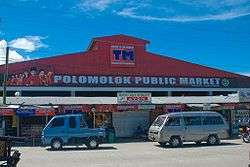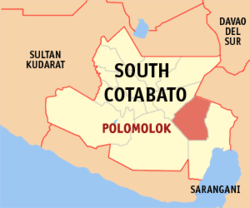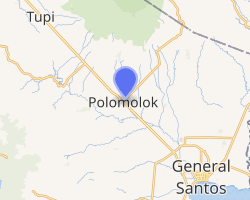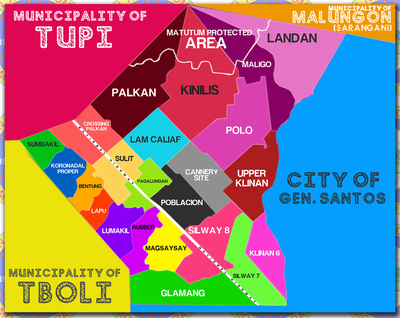Polomolok
Polomolok, officially the Municipality of Polomolok (Hiligaynon: Banwa sang Polomolok; Cebuano: Lungsod sa Polomolok; Tagalog: Bayan ng Polomolok), is a 1st class municipality in the province of South Cotabato, Philippines. According to the 2015 census, it has a population of 152,589 people.[3]
Polomolok | |
|---|---|
| Municipality of Polomolok | |
 Polomolok Public Market | |
 Seal | |
Nickname(s):
| |
| Motto(s): Padayon Polomolok! | |
 Map of South Cotabato with Polomolok highlighted | |
OpenStreetMap 
| |
.svg.png) Polomolok Location within the Philippines | |
| Coordinates: 6°13′N 125°04′E | |
| Country | |
| Region | Soccsksargen (Region XII) |
| Province | South Cotabato |
| District | 1st District |
| Date of Creation | August 21, 1957 |
| Founded | September 10, 1957 |
| Barangays | 23 (see Barangays) |
| Government | |
| • Type | Sangguniang Bayan |
| • Mayor | Honey L. Lumayag-Matti |
| • Vice Mayor | Xavier J. Bayan |
| • Electorate | 99,820 voters (2019) |
| Area | |
| • Total | 339.97 km2 (131.26 sq mi) |
| Population (2015 census)[3] | |
| • Total | 152,589 |
| • Density | 450/km2 (1,200/sq mi) |
| • Households | 36,485 |
| Economy | |
| • Income class | 1st municipal income class |
| • Poverty incidence | 24.6% (2015)[4] |
| • Revenue (₱) | 414,171,343.13 (2016) |
| Time zone | UTC+8 (PST) |
| ZIP code | 9504 |
| PSGC | |
| IDD : area code | +63 (0)83 |
| Climate type | tropical rainforest climate |
| Native languages | Hiligaynon Cebuano Maguindanao Blaan language Tagalog |
| Website | polomolok |
It is located between General Santos and Tupi. Polomolok is seated about 41 kilometres (25 mi) south-east of the provincial capital city of Koronadal, 17 kilometres (11 mi) north of the port city of General Santos and 1,030 kilometres (640 mi) south-east of the national capital Manila. The municipality ranks 21st in the largest income earner municipalities of the Philippines.[5] As of 2016, it is the wealthiest Municipality in Mindanao with PhP 1.47 Billion worth of assets and in 2017, Polomolok is the 7th Most Competitive Municipality in Mindanao for the year 2018.[6] Polomolok also serves as the chief town in the 1st District of South Cotabato.
Polomolok already filed a resolution to the Congress for Polomolok to become a city.[7]
History
The name Polomolok was derived from the B’laan term flomlok, which means hunting ground. In the early years, the place where the Poblacion is presently situated was known for its abundance of wild life. There were no roads and the lowlanders befriended the B’laan highlanders and utilized them as guides. Aside from a rich hunting ground, Polomolok had so many creeks with free flowing water coming from the hillsides. Those cool and clear flowing water encouraged foreigners to settle in this place. One of them was a Japanese trader Zenjiro Takahashi and his B’laan wife. He began clearing the area and planted agricultural crops. Not long after, some of the Christians came to settle and started to clear the area.
In 1940, the Philippines Commonwealth government embarked on a very bold program of social amelioration. One of the projects was the distribution of lands to interested people who wanted to settle in Mindanao. Settlers were brought by boat to Dadiangas (General Santos) from Luzon and Visayas. On November 2, 1940, Polomolok was officially opened for settlement and known as Polomok Settlement District. Atty. Ernesto Jimenez was appointed as its first overseer. He was responsible for the allocation of farm lots. Then came the creation of some barrios of the settlers. These were Palkan, Lemblisong, Polo, Polomolok Central (now Poblacion), Polomolok Creek (now Magsaysay), Sulit, Lamcaliaf, Kinilis, Glamang, Bentung, Koronadal Proper, Leve, and Silway. The first settlers, after a crop or two, started to invite their friends and relatives to settle in this place, because the soil was so fertile that any crop can survive due to favorable climate conditions.
The settlement program was interrupted for four years by the Second World War. Don Francisco Natividad was appointed Military Mayor with Datu Badung Nilong as Vice Mayor and Sgt. Nuevarez as Chief of Police. In 1948, Perfecto Balili was designated NLSA Administrator with Rosendo Sarte as Officer-In-Charge. In 1954, the NLSA was abolished in the course of government reorganization. All records of NLSA were taken over by the Board of Liquidators. The Municipality of General Santos (formerly Buayan) was incorporated.
On August 21, 1957, the Municipality of Polomolok was created by virtue of a Presidential Executive Order No. 264 signed by President Carlos P. Garcia. It started functioning as a regular and independent municipality on September 10, 1957, as a 6th class municipality. The local officials were appointed by the President. Its first appointed Mayor was Datu Badong Nilong.
From 1957 to 1963, the progress of this town was still very slow. Fields have always been green, harvest bountiful but farm products had low market value and circulation of cash was rather slow. Then came a breakthrough, when the largest pineapple company, the Dole Philippines Inc., was planted and inaugurated on December 7, 1963.
Geography
Located at the southern part of South Cotabato, Polomolok is nestled at the base of the prominent Mount Matutum. It is cone-shaped volcano and looms over the provinces at 2,286 metres (7,500 ft) high, a unique challenge to mountaineers. It is perhaps the provinces most imposing landmark.
Natural hot and cold spring abound at its foot. Natural springs are abundant within this area and provide free flowing water. Two of these springs have developed into natural resorts.
Climate
Polomolok features a tropical rainforest climate (Af), according to the Köppen-Geiger climate classification, with significant rainfall year-round and constantly hot temperatures. Since this tropical rainforest climate is more subject to the Intertropical Convergence Zone than the trade winds and experiences very few cyclones, it is subequatorial. The city experiences considerable rainfall during the year, even during the driest month. The average annual temperature is 25.7 °C in Polomolok. In a year, the average rainfall is 1410 mm. March is the driest month, and June is the wettest month in the city.
| Climate data for Polomolok, South Cotabato | |||||||||||||
|---|---|---|---|---|---|---|---|---|---|---|---|---|---|
| Month | Jan | Feb | Mar | Apr | May | Jun | Jul | Aug | Sep | Oct | Nov | Dec | Year |
| Average high °C (°F) | 29 (84) |
29 (84) |
30 (86) |
30 (86) |
29 (84) |
28 (82) |
28 (82) |
28 (82) |
29 (84) |
28 (82) |
29 (84) |
29 (84) |
29 (84) |
| Average low °C (°F) | 21 (70) |
21 (70) |
21 (70) |
22 (72) |
23 (73) |
23 (73) |
22 (72) |
22 (72) |
22 (72) |
23 (73) |
22 (72) |
22 (72) |
22 (72) |
| Average precipitation mm (inches) | 54 (2.1) |
41 (1.6) |
56 (2.2) |
81 (3.2) |
154 (6.1) |
212 (8.3) |
223 (8.8) |
218 (8.6) |
192 (7.6) |
184 (7.2) |
135 (5.3) |
73 (2.9) |
1,623 (63.9) |
| Average rainy days | 10.4 | 9.1 | 11.2 | 14.4 | 24.6 | 27.0 | 26.7 | 26.1 | 25.6 | 26.9 | 22.6 | 15.1 | 239.7 |
| Source: Meteoblue [9] | |||||||||||||
Barangays
Polomolok is politically subdivided into 23 barangays. Barangay Poblacion is also known as Polomolok itself. There are 4 urban barangays and 19 rural barangays.

| Barangay/s | Population (2015) | Urbanisation |
|---|---|---|
| Poblacion (Polomolok) | 45,298 | Urban |
| Cannery Site | 23,310 | Urban |
| Magsaysay | 12,156 | Urban |
| Bentung | 1,374 | Rural |
| Crossing Palkan | 1,967 | Rural |
| Glamang | 7,061 | Rural |
| Kinilis | 1,717 | Rural |
| Klinan 6 | 3,594 | Rural |
| Koronadal Proper | 3,976 | Rural |
| Lam Caliaf | 1,388 | Rural |
| Landan | 6,004 | Rural |
| Lapu | 2,242 | Rural |
| Lumakil | 3,410 | Rural |
| Maligo | 3,165 | Rural |
| Pagalungan | 2,915 | Rural |
| Palkan | 3,766 | Rural |
| Polo | 2,468 | Rural |
| Rubber | 3,149 | Rural |
| Silway 7 | 2,433 | Rural |
| Silway 8 | 10,477 | Urban |
| Sulit | 5,083 | Rural |
| Sumbakil | 1,794 | Rural |
| Upper Klinan | 3,872 | Rural |
Demographics
| Year | Pop. | ±% p.a. |
|---|---|---|
| 1960 | 15,536 | — |
| 1970 | 32,570 | +7.67% |
| 1975 | 40,544 | +4.49% |
| 1980 | 59,312 | +7.90% |
| 1990 | 89,372 | +4.19% |
| 1995 | 96,274 | +1.40% |
| 2000 | 110,709 | +3.04% |
| 2007 | 131,436 | +2.40% |
| 2010 | 138,273 | +1.86% |
| 2015 | 152,589 | +1.89% |
| Source: Philippine Statistics Authority[3][10][11][12] | ||
Polomolok has a population of 152,789 people as per census data of 2015,[13] thus making it the most populated municipality (next to Koronadal City) in the province.
Based on its population, it is the most populous municipality in Mindanao, the largest municipality in the SOCCSKSARGEN Region and 17th most populous municipality[14] in the Philippines. Cebuano is widely spoken and is the native language of majority of the municipality's inhabitants.
Economy
The Municipality of Polomolok prides its successful implementation of its Revenue Generation Program as an exemplary practice. The purpose of the program is to increase local revenues from collection of real property taxes and other fees and charges; update Municipal Tax Ordinance; Conduct Business Tax Mapping; and system automation. Rank 3rd on the rich municipalities and cities in Mindanao with less percentage of poverty incidence.[15]
Agriculture
It is splendidly gifted with pineapple products and processing, livestock resources (cattle, swine production, meat packaging) furniture, asparagus and cut flowers, cotton ginnery, corn, vegetable and fruits.

Dole Philippines Incorporated is the largest industrial firm involved in growing, processing and exporting of fresh and canned pineapple. As of 2004, the area planted to pineapple is 15,507.872 hectares with an average production volume of 31.94 metric tons per hectare. This industry, which is situated at Barangay Cannery Site, generates about 6,000 jobs at present. It is considered as the biggest taxpayer in the municipality.
Corn is the second most grown crop in the municipality. Data from the Agriculture Office revealed that for the year 2003 there are 3,931 hectares or 13.46% of the total cultivated land agricultural lands were devoted to corn. About 1,236 hectares of which are planted to traditional corn seeds at average production of 3.20 MT/hectare and 2,695 hectares are planted to hybrid corn at average production of 4.0 MT/ hectare. The major producers are Barangay Klinan 6, Glamang, Landan, Silway 8 and Upper Klinan. About 30% of populace adopt corn as their staple food.
Rice is also one of the major crops. 99% of the total population has rice as their staple food. Office of the Agriculturist reported that for the year 2006, 445 hectares were utilized for rice production, of which only 300 hectares are irrigated, 45 are lowland, and 100 are upland. Irrigated areas are planted 2.5 time a year while rainfed and upland are planted only once. "Gintoang Masaganang Ani Program" Program targets for the average production of rice at about 4.5 MT, for irrigated, 3 MT for lowland and 1.5 MT for upland. This target was met by the farmers this year because of rice diseases and pest infestation.
The record of the Department of Agriculture shows that as of 2006, the total area planted with asparagus is 1,435.52 hectares. Plantations of this crop are in Barangay Sulit, Sumbakil, Crossing Palkan, Bentung, Lapu, Pagalungan, Lumakil, Rubber and Magsaysay. Farmer growers have access to the export market due to contract agreement with Marsman-Drysdale Agri-Ventures and Tropifresh. The surplus are sold in the local market and diversifically used as supplements for cattle fattening.

Vegetables grow well in Barangay Palkan, Kinilis, Maligo, Sumbakil and Koronadal Proper where the climate is cool and the soil is fertile. However, the farmers cannot really produce in large volume due to financial constraints and unstable prevailing market prices of vegetables.
Livestock and poultry production has increased tremendously in the past years. This is partly due to the municipality's climate and terrain which is ideal for livestock and poultry production. The land area devoted for agri-livestock production is 80 hectares or 0.27 percent of the total agricultural land.
For the year 2006, the Office of the Municipal Agriculturist reported that there are 322,628 heads of livestocks and poultry raised in the municipality. Poultry has the most number of heads at 271,420 where 3,639 are layers, 17,852 are backyard, and 249,929 are commercial under contract growers scheme with different Agri-business firms such as RFM, Vitarich, and Swift followed by swine with 23,719 heads which 10,970 are backyard and a total of 15,113 are raised commercially, and cattle with 24,491 heads where 2,065 are backyard and a total of 22,426 heads fattened in the cattle farms of Montery and DEALCO.
Supply of livestock in the municipality is insufficient due to shipment of livestock which are raised commercially to other parts of the country leaving the backyard raisers to support the local market. The municipality still depend on supplies coming from other areas in the province.
Income classification
Polomolok has a total income of PhP 414,171,343.10 as of 2016 certified by the Commission on Audit and Bureau of Local Government Finance. It is a 1st class municipality.
Polomolok is considered as the wealthiest and richest municipality in Mindanao.
Festivals
- FlomLok Festival is a Municipal-wide festival which represents the early inhabitants of the town.
- Pinyahan Festival is the Foundation Anniversary of the Barangay Cannery Site.
- Malambuon Festival is the Foundation Anniversary of the Barangay Poblacion.
- Manghoy Festival is the Foundation Anniversary of the Barangay Silway 8.
- Mahamungaya Festival is the Foundation Anniversary of the Barangay Sulit.
- Keflehew Festival is the Foundation Anniversary of the Barangay Landan.
- Cassabaka Festival is the Foundation Anniversary of the Barangay Klinan 6.
- Palamanyogan Festival is the Foundation Anniversary of the Barangay Lumakil.
- Kabulakan Festival is the Foundation Anniversary of the Barangay Palkan.
- Tuburan Festival is the Foundation Anniversary of the Barangay Pagalungan.
- Kaumahan Festival is the Foundation Anniversary of the Barangay Polo.
Transportation
- By land
The Polomolok Terminal has its daily trip to General Santos City and Koronadal City for 24 hours.
The estimated time allotment from Polomolok to General Santos and vice versa is only 15~20 minutes. From General Santos City, there is a 24/7 trip to Polomolok, the PUVs along National Highway near NDDU.
- By sea
The General Santos City Seaport is accessible to Polomolok, there used to be daily trips from Manila to General Santos through 2GO Travel and other shipping companies.
- By air
General Santos International Airport is 20 minutes away from Polomolok's town proper by using the newly constructed General Santos City Diversion Road (roundabout) to avoid heavy traffic along Lanoy Highway in Barangay Calumpang, General Santos City.
Media
Most of the FM, AM radio and TV stations are based in General Santos City.
- DXXR The first and only Christian Radio Station in the town.
- ABS-CBN General Santos Channel 3 (defunct)
- GMA General Santos Channel 8
- TV5 General Santos Channel 12
- GMA News TV Channel 26
- Brigada News TV GenSan Channel 34
- ABS-CBN Sports+Action Channel 36 (defunct)
- EGTV Channel 46[16][17]
Hospitals
Among the notable hospitals in Polomolok are
- Howard Hubbard Memorial Hospital
- Heramil Hospital
- Bontuyan Medical Hospital Inc.
- Polomolok District Hospital
Banking institutions
- Landbank of the Philippines (LBP)
- Rizal Commercial Banking Corporation (RCBC)
- Development Bank of the Philippines (DBP)
- Metropolitan Bank and Trust Company (Metrobank, MBTC)
- Peninsula Bank (Penbank)
- Banco de Oro (BDO Unibank)
Shopping malls
- Gaisano Grand Mall Polomolok
- Friendly Mart (Formerly FitMart - Polomolok)
- TLG Shoppers Mart - Polomolok
- Price Smart Super Store - Polomolok
Education
- College and vocational schools
- Notre Dame — Siena College of Polomolok
- General Santos Academy, Inc.
- BEST College of Polomolok, Inc.
- Schola De San Jose
- Philippine Millennium Colleges
- St. Therese Blue Collar Institute
- Notre Dame of Dadiangas University - College of Architecture, Engineering and Technology (Glamang Campus) commenced in 2018
- High schools and elementary schools
- General Santos Academy, Inc.
- St. Lorenzo School of Polomolok, Inc.
- Poblacion Polomolok National High School
- Notre Dame-Siena College of Polomolok
- Dole Philippines School
- Polomolok National High School
- Christian School of Polomolok
- BEST School of Polomolok
- Dole Cannery Central Elementary School
- Bentung Sulit National High School
- Dolefil Seventh Day Adventist Elementary School
- Matutum View Baptist Academy, Inc.
- Mt. Matutum Christian School
- Southern SDA of Polomolok
- Upper Klinan National High School
- Silway 8 National High School
- Polomolok Central Elementary School
- Power Purple Children School
- Eugenio Llido Rañada Elementary School
- Eustacio Barcatan Elementary School
- Perfecto B. Salada Elementary School
- Lamcuah Elementary School
- Maligo Elementary School
- Cassava Elementary School
- Kawit Elementary School
- Landan Elementary School
- Kalyong Elementary School
- Pagalungan Elementary School
- Polo Elementary School/ Polo Integrated School
- Upper Klinan Elementary School
- Silway 7 Elementary School
- Klinan Elementary School
- Juan Bayan Elementary School
References
- "Municipality". Quezon City, Philippines: Department of the Interior and Local Government. Retrieved 31 May 2013.
- "Province: South Cotabato". PSGC Interactive. Quezon City, Philippines: Philippine Statistics Authority. Retrieved 12 November 2016.
- Census of Population (2015). "Region XII (Soccsksargen)". Total Population by Province, City, Municipality and Barangay. PSA. Retrieved 20 June 2016.
- "PSA releases the 2015 Municipal and City Level Poverty Estimates". Quezon City, Philippines. Retrieved 12 October 2019.
- "Largest Income Earner Municipalities of the Philippines" (PDF). Commission on Audit, Republic of the Philippines. Retrieved 2012-06-28.
- "Most Competitive Municipality in Mindanao". Cities and Municipalities Competitive Index.
- "Polomolok meets requirements for cityhood". Mindanao Economic Boom.
- http://www.accuweather.com/en/ph/polomolok/266055/weather-forecast/266055
- "Polomonok: Average Temperatures and Rainfall". Meteoblue. Retrieved 23 May 2020.
- Census of Population and Housing (2010). "Region XII (Soccsksargen)". Total Population by Province, City, Municipality and Barangay. NSO. Retrieved 29 June 2016.
- Censuses of Population (1903–2007). "Region XII (Soccsksargen)". Table 1. Population Enumerated in Various Censuses by Province/Highly Urbanized City: 1903 to 2007. NSO.
- "Province of South Cotabato". Municipality Population Data. Local Water Utilities Administration Research Division. Retrieved 17 December 2016.
- Philippine Statistics Authority 2010 Census: Population and Annual Growth Rates for The Philippines and Its Regions, Provinces, and Highly Urbanized Cities Archived 2012-07-07 at Archive.today
- List of Philippine cities and municipalities by population
- "Kidapawan is Mindanao's richest city". Manila Bulletin. Archived from the original on 2012-03-24. Retrieved 2011-08-07.
- http://egtv38.com/demo-home-2/about-us/
- "Archived copy". Archived from the original on 2016-01-11. Retrieved 2015-12-07.CS1 maint: archived copy as title (link)
External links
| Wikimedia Commons has media related to Polomolok, South Cotabato. |
